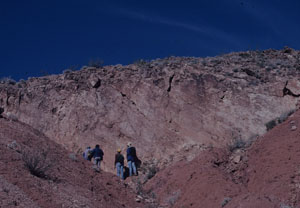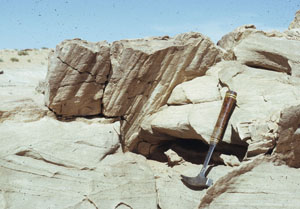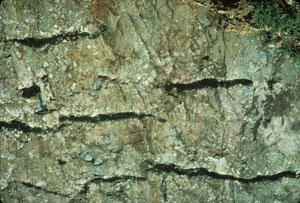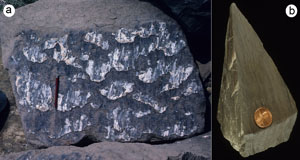| ||||||||||||
|
|
||||||||||||
|
|
||||||||||||
| Surface Morphology of Faults | ||||||||||||
|
Striations are the ridge-and-grooves or lines inscribed on the surface of a rock, produced by a geological process such as faulting, mass movement, and glacial flow. The striations usually occur in an array of roughly parallel lines (Figure 1 and Figure 2) in the slip direction. However, it is possible that slip direction on a given fault may vary spatially and temporarily resulting small or drastic variations in the orientation of striations across the surface and sometimes in overlapping striation patterns.
Another feature of a fault surface is the so-called steps or chatter marks (Figure 3) which are oriented perpendicular to the sip direction. These marks are sometimes used to infer the relative movement sense of the fault blocks based on the ease of a hand movement across the marks. However, this rule is risky without understanding the particular formation mechanisms of the marks. Figures 4(a and b) demonstrate one case where steps are filled by calcite and are associated with a particular segment geometry such that knowing the dilation between echelon segments permits to determine the sense of slip across the surface. If the steps are formed by, for example, small faults or slightly sheared joints may result in steps which are not likely to be relevant to the original slip sense on the main fault surface.
Figures 5(a and b) and Figures 6(a and b) from Sagy et al. (2007) show a ground-based Lidar image of the surface of Dixie Valley fault, Nevada. This fault is a normal fault in fine crystalline rocks with larger than 10 meter slip. Sagy and his coworkers analyzed several fault surfaces with various slip magnitudes using Lidar and Laser Profilemeter and determined that the profiles parallel to slip are smoother (have lower spectral densities) than those normal to slip. They also studied the surface roughness of several faults with varying slip and found that the faults with larger slip are smoother. Kaven and Pollard (2009) and Kaven (2010) analyzed fault surfaces using differential geometry and curvature types and proposed several categories useful for understanding their influences on the stress state on the fault surfaces. | ||||||||||||
| Reference: |
||||||||||||
| Aydin, A., Johnson, A.M., 1978 Campagna, D.J., Aydin, A., 1991 Kaven, J. O., Pollard, D.D., 2009 Kaven, J. O., 2010 Sagy, A., Brodsky, E.E., Axen, G.J., 2007 |
||||||||||||
|
Readme | About Us | Acknowledgement | How to Cite | Terms of Use | Ⓒ Rock Fracture Knowledgebase |
||||||||||||





